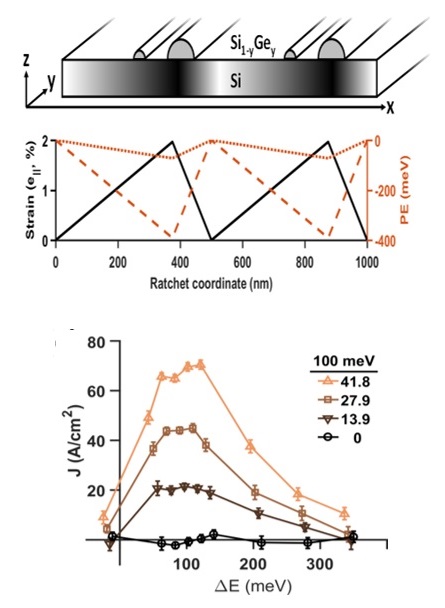A Silicon Ratchet to Produce Power from Below-Bandgap Photons
Scientific Achievement
We show, with a 3D model of silicon under incoherent THz irradiation, that below-bandgap excitations (free carrier or intraband absorptions) can do useful work by exciting, i.e. flashing, electrons in and out of a structurally embedded ratchet potential.

Top: Schematic of the device simulated. Multiple strips of silicon-germanium alloy could create the strain gradients (shown as graded shaded regions) in an experimental system. Middle: the ratchet potential (orange) that results from gradients in parallel strain along the x-direction.
Bottom: Current density as a function of the average depth of the wells in the ratchet potential, ∆E, for irradiation of the Si ratchet with 100 meV photons and a series of irradiances (MW/cm2).
Significance and Impact
This new photovoltaic mechanism uses wasted below-bandgap absorptions to enhance the directional diffusion of charge carriers, and could be used to augment the efficiency of traditional photovoltaics.
Research Details
- A periodic sawtooth potential, realized through elastic strain gradients along a 100 nm thick Si slab, biases the oscillatory motion of excited electrons, which preferentially jump and relax into the adjacent period on the right to generate a net current.
- The magnitude of the ratchet current peaks as a function of the well depth of the ratchet potential, and the dominant mode of energy loss (the 62 meV intervalley phonon).
A Silicon Ratchet to Produce Power from Below-Bandgap Photons
Lau, B., Kedem, O., Kodaimati, M., Ratner, M.A., Weiss, E.A.
Adv. Energy Mater., 2017, 1701000.
Work performed at Northwestern University
